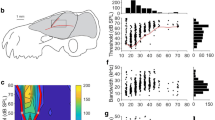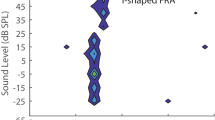Summary
-
1.
Frequency and space representation in the auditory cortex of the big brown bat,Eptesicus fuscus, were studied by recording responses of 223 neurons to acoustic stimuli presented in the bat's frontal auditory space.
-
2.
The majority of the auditory cortical neurons were recorded at a depth of less than 500 urn with a response latency between 8 and 20 ms (Fig. 1 B, C). They generally discharged phasically and had nonmonotonic intensity-rate functions (Fig. 3). The minimum threshold, (MT) of these neurons was between 8 and 82 dB sound pressure level (SPL). Half of the cortical neurons showed spontaneous activity. All 55 threshold curves are Vshaped and can be described as broad, intermediate, or narrow (Fig. 4A).
-
3.
Auditory cortical neurons are tonotopically organized along the anteroposterior axis of the auditory cortex. High-frequency-sensitive neurons are located anteriorly and low-frequency-sensitive neurons posteriorly (Figs. 5, 6). An overwhelming majority of neurons were sensitive to a frequency range between 30 and 75 kHz (Fig. 1 A).
-
4.
When a sound was delivered from the response center of a neuron on the bat's frontal auditory space, the neuron had its lowest MT. When the stimulus amplitude was increased above the MT, the neuron responded to sound delivered within a defined spatial area. The response center was not always at the geometric center of the spatial response area. The latter also expanded with stimulus amplitude (Fig. 8). High-frequency-sensitive neurons tended to have smaller spatial response areas than low-frequency-sensitive neurons (Figs. 7, 9).
-
5.
Response centers of all 223 neurons were located between 0‡ and 50‡ in azimuth, 2‡ up and 25‡ down in elevation of the contralateral frontal auditory space (Fig. 10). Response centers of auditory cortical neurons tended to move toward the midline and slightly downward with increasing best frequency (BF; Fig. 11).
-
6.
Auditory space representation appears to be systematically arranged according to the tonotopic axis of the auditory cortex. Thus, the lateral space is represented posteriorly and the middle space anteriorly (Fig. 12). Space representation, however, is less systematic in the vertical direction (Fig. 13).
-
7.
Auditory cortical neurons are columnarly organized. Thus, the BFs, MTs, threshold curves, azimuthal location of response centers, and auditory spatial response areas of neurons sequentially isolated from an orthogonal electrode penetration are similar (Figs. 4, 7).
Similar content being viewed by others
Abbreviations
- AC :
-
auditory cortex
- BF :
-
best frequency
- CF :
-
constant frequency
- FM :
-
frequency modulated, modulating
- MLD :
-
nucleus mesencephalicus lateralis dorsalis
- MT :
-
minimum threshold
- Q 10 BF:
-
divided by bandwidth of threshold curve at 10 dB above the MT
- SPL :
-
sound pressure level
References
Asanuma A, Wong D, Suga N (1983) Frequency and amplitude representations in anterior primary auditory cortex of the mustache bat. J Neurophysiol 50:1182–1196
Beranek LL (1954) Acoustics. Bolt, Beranek and Newman, Cambridge, MA (Reprinted by American Institute of Physics, 1986)
Fuzessery ZM, Pollak GD (1984) Neural mechanisms of sound localization in an echolocating bat. Science 225:725–727
Fuzessery ZM, Pollak GD (1985) Determinants of sound location selectivity in bat inferior colliculus: a combined dichotic and free-field stimulation study. J Neurophysiol 54:757–781
Griffin DR (1958) Listening in the dark. Yale University Press, New Haven, CT (Reprinted by Dover Publications, New York, 1974)
Grinnell AD (1963) The neurophysiology of audition in bats: directional localization and binaural interaction. J Physiol (Lond) 167:97–113
Grinnell AD, Grinnell VS (1965) Neural correlates of vertical localization by echolocating bats. J Physiol (Lond) 181:830–851
Henson OW (1970) The ear and audition. In: Wimsatt WA (ed) Biology of bats, vol. 2, Chap. 4. Academic, New York
Hubel DH, Wiesel TN (1963) Shape and arrangement of columns in cat's striate cortex. J Physiol (Lond) 165:559–568
Hubel DH, Wiesel TN (1974) Sequence regularity and geometry of orientation columns in the monkey striate cortex. J Comp Neurol 158:267–294
Imig TJ, Adrian HO (1977) Binaural columns in the primary field (AI) of cat auditory cortex. Brain Res 138:241–257
Imig TJ, Ruggero MA, Kitzes LM, Javel E, Brugge JF (1977) Organization of auditory cortex in the owl monkeyAotus trivirgatus. J Comp Neurol 171:111–128
Jen PH-S (1974) Coding of directional information by single neurons in the superior olivary complex of echolocating bats. PhD thesis, Washington University, St. Louis
Jen PH-S (1980) Coding of directional information by single neurons of the S-segment of the FM bat,Myotis lucifugus. J Exp Biol 87:203–216
Jen PH-S, Chen DM (1988) Directionality of sound pressure transformation at the pinna of echolocating bats. Hearing Res 34:101–118
Jen PH-S, Schlegel PA (1982) Auditory physiological properties of the neurons in the inferior colliculus of the big brown bat,Eptesicus fuscus. J Comp Physiol 147:351–363
Jen PH-S, Sun XD (1984) Pinna orientation determines the maximal directional sensitivity of bat auditory neurons. Brain Res 301:157–161
Jen PH-S, Sun XD, Kamada T, Zhang SQ, Shimozawa T (1984a) Auditory response properties and spatial response areas of superior collicular neurons of the FM batEptesicus fuscus. J Comp Physiol A 154:407–413
Jen PH-S, Kamada T, Sun XD, Schlegel P, Vater M, Harnischfeger G, Rübsamen R (1984b) Responses of cerebellar neurons to acoustic stimuli in certain FM and CF-FM bats. Chinese J Physiol 27:1–26
Jen PH-S, Sun XD, Chen DM, Teng HB (1987) Auditory space representation in the inferior colliculus of the FM bat,Eptesicus fuscus. Brain Res 419:7–18
Knudsen EI (1982) Auditory and visual maps of space in the optic tectum of the owl. J Neurosci 9:1177–1194
Knudsen EI, Konishi M (1978a) Space and frequency are represented separately in the auditory midbrain of the owl. J Neurophysiol 41:870–884
Knudsen EI, Konishi M (1978b) A neural map of auditory space in the owl. Science 200:795–797
Kujirai K, Suga N (1983) Tonotopic representation and space map in the non-primary auditory cortex of the mustached bat. Auris Nasus Larynx 10:9–24
Lauter JL, Herscovitch P, Formby C, Raichle M (1985) Tonotopic organization in human auditory cortex revealed by positron emission tomography. Hearing Res 20:199–205
Makous JC, O'Neill WE (1986) Directional sensitivity of the auditory midbrain in the mustached bat to free-field tones. Hearing Res 24:73–88
Manabe T, Suga N, Ostwald J (1978) Aural representation in the Doppler-shifted-CF processing area of the primary auditory cortex of the mustached bat. Science 200:339–342
Merzenich MM, Brugge JF (1973) Representation of the cochlear partition on the superior temporal plane of the macaque monkey. Brain Res 50:275–296
Merzenich MM, Knight PL, Roth GL (1975) Representation of cochlea within primary auditory cortex in the cat. J Neurophysiol 38:231–249
Michael CR (1981) Columnar organization of color cells in monkey's striate cortex. J Neurophysiol 46:587–604
Mountcastle VB (1957) Modality and topographic properties of single neurons of cat's somatic sensory cortex. J Neurophysiol 20:408–434
Neuweiler G (1970) Neurophysiologische Untersuchungen zum Echoortungssystem der Gro\en HufeisennaseRhinolophus ferrumequinum. Z Vergl Physiol 67:273–306
Ostwald J (1984) Tonotopical organization and pure tone response characteristics of single units in the auditory cortex of the greater horseshoe bat. J Comp Physiol A 155:821–834
Pollak GD, Bodenhamer RD (1981) Specialized characteristics of single units in inferior colliculus of mustache bat: frequency representation tuning, and discharge patterns. J Neurophysiol 46:605–620
Pollak GD, Bodenhamer RD, Zook JM (1983) Cochleotopic organization of the mustache bat's inferior colliculus. In: Ewert JP, Capranica RR, Ingle DJ (eds) Advances in vertebrate neuroethology. New York. Plenum Press, pp 925–935
Poussin C, Schlegel P (1984) Directional sensitivity of auditory neurons in the superior colliculus of the bat,Eptesicus fuscus using free field sound stimulation. J Comp Physiol A 154:253–261
Reale RA, Imig TJ (1980) Tono topic organization in auditory cortex of the cat. J Comp Neurol 192:265–291
Schlegel P (1977) Directional coding by binaural brainstem units of CF-FM bat,Rhinolophus ferrumequinum. J Comp Physiol 118:327–352
Schlegel PA, Jen PH-S, Singh S (1988) Auditory spatial sensitivity of inferior collicular neurons in echolocating bats. Brain Res 456:127–138
Schuller G, Pollak G (1979) Disproportionate frequency representation in the inferior colliculus of Doppler-compensating greater horseshoe bats: Evidence of an acoustic fovea. J Comp Physiol 132:47–54
Schweizer H (1981) The connections of the inferior colliculus and the organization of the brainstem auditory system in the greater horseshoe bat (Rhinolophus ferrumequinum). J Comp Neurol 201:25–49
Shimozawa T, Suga N, Hendler P, Schuetze S (1974) Directional sensitivity of echolocation systems in bats producing frequency-modulated signals. J Exp Biol 60:53–59
Shimozawa T, Sun XD, Jen PH-S (1984) Auditory space representation in the superior colliculus of the big brown bat,Eptesicus fuscus. Brain Res 311:289–296
Simmons JA, Fenton MD, O'Farrell MJ (1979) Echolocation and pursuit of prey by bats. Science 2032:16–21
Suga N (1964) Single unit activity in cochlear nucleus and inferior colliculus of echolocating bats. J Physiol 172:449–474
Suga N (1965) Functional properties of auditory neurons in the cortex of echolocating bats. J Physiol 181:671–700
Suga N (1977) Amplitude-spectrum representation in the Doppler-shifted-CF processing area of the auditory cortex of the mustached bat. Science 196:64–67
Suga N (1984) The extent to which biosonar information is represented in the bat auditory cortex. In: Edelman GM, Gall WE, Cowan WM (eds) Dynamic aspects of neocortical function. Wiley, New York, pp 315–373
Suga N, Jen PH-S (1976) Disproportionate tonotopic representation for processing species-specific CF-FM sonor signals in the mustached bat auditory cortex. Science 194:542–544
Suga N, Jen PH-S (1977) Further studies on the peripheral auditory system of the ‘CF-FM’ bats specialized for the fine frequency analysis of Doppler-shifted echoes. J Exp Biol 69:207–232
Suga N, Manabe T (1982) Neural basis of amplitude-spectrum representation in auditory cortex of the mustached bat. J Neurophysiol 47:225–255
Suga N, Schlegel PA (1972) Neural attenuation of responses to emitted sounds in echolocating bats. Science 177:82–84
Suga N, Simmons JA, Jen PH-S (1975) Peripheral specialization for fine analysis of Doppler-shifted echoes in ‘CF-FM’ batPteronotus p. parnellii. J Exp Biol 63:161–192
Sullivan WE (1982) Neural representation of target distance in auditory cortex of the echolocating batMyotis lucifugus. J Neurophysiol 48:1011–1032
Sun XD, Jen PH-S (1987) Pinna position affects the auditory space representation in the inferior colliculus of the FM bat,Eptesicus fuscus. Hear Res 27:207–219
Sun XD, Jen PH-S, Kamada T (1983) Mapping of the auditory area in the cerebellar vermis and hemispheres of the mustache bat,Pteronotus parnellii parnellii. Brain Res 271:162–165
Sun XD, Jen PH-S, Zhang WP (1987) Auditory spatial response areas of single neurons and space representation in the cerebellum of echolocating bats. Brain Res 414:314–322
Taniguchi I, Arai O, Saito N (1988) Functional laminar and columnar organization of the auditory centers in echolocating Japanese greater horseshoe bats. Neurosci Lett 88:17–20
Tunturi AR (1944) Audio frequency localization in the acoustic cortex of the dog. Am J Physiol 141:397–403
Van Essen DC, Zeki SM (1978) The topographic organization of rhesus monkey prestriate cortex. J Physiol 277:193–226
Wong D (1984) Spatial tuning of auditory neurons in the superior colliculus of the echolocating batMyotis lucifugus. Hearing Res 16:261–270
Wong D, Shannon SL (1988) Functional zones in the auditory cortex of the echolocating bat,Myotis lucifugus. Brain Res 453:349–352
Woolsey CN, Walzl EM (1941) Topical projection of nerve fibers from local regions of the cochlea to the cerebral cortex of the cat. Am J Physiol 133:498–499
Zook JM, Casseday JH (1982) Origin of ascending projections of inferior colliculus in the mustache bat,Pteronotus parnellii. J Comp Neurol 207:14–28
Zook JM, Winer JA, Pollak GD, Bodenhamer RD (1985) Topology of the central nucleus of the mustache bat's inferior colliculus: correlation of single unit properties and neural architecture. J Comp Neurol 231:530–546
Author information
Authors and Affiliations
Rights and permissions
About this article
Cite this article
Jen, P.H.S., Sun, X. & Lin, P.J.J. Frequency and space representation in the primary auditory cortex of the frequency modulating batEptesicus fuscus . J. Comp. Physiol. 165, 1–14 (1989). https://doi.org/10.1007/BF00613794
Accepted:
Issue Date:
DOI: https://doi.org/10.1007/BF00613794




